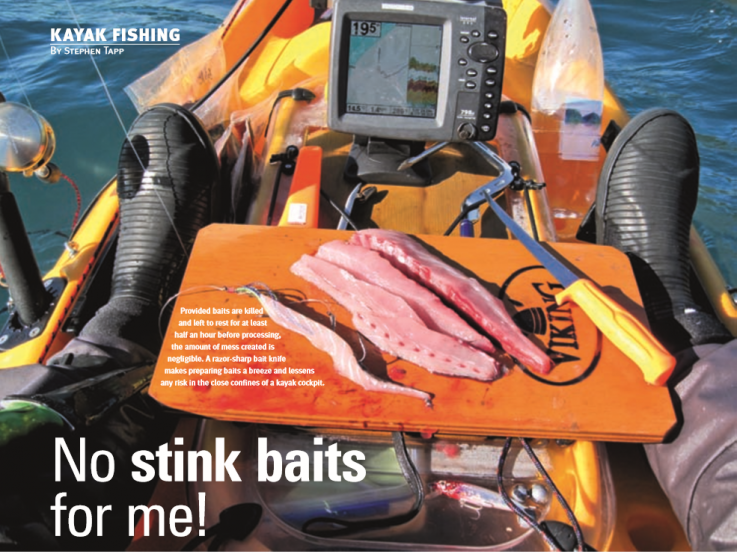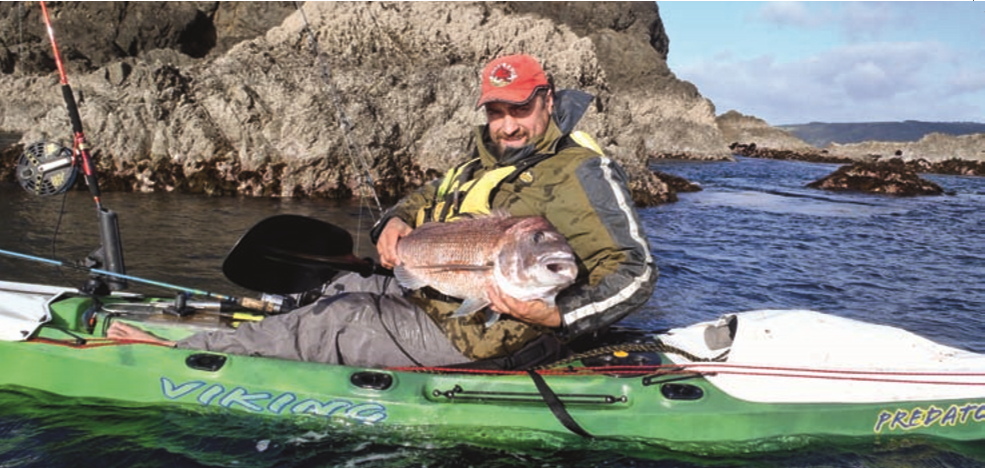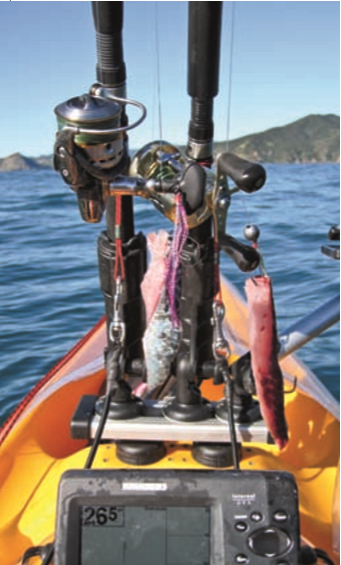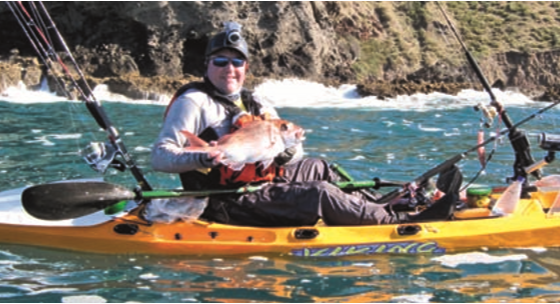Big Baits, Big Fish! fresh baits
8:42PM 28th Sep 13

Over the years one of my core secrets to catching good fish has been using the best possible bait. Fresh or frozen, perfect baits should be good enough to eat – in other words, food grade. This is even more critical when considering baits like pilchards, which quickly lose their shine and can become soft and unusable when not stored correctly. With cut baits any ‘stink’ means they’re not fresh and long past their use-by date! In fact, I rate this so highly when purchasing frozen baits, the first thing they have to pass is the whiff test! By Stephen Tapp for the NZ Fishing News magazine
Big baits, big fish! How many times have we heard this adage?
Certainly when I was land-based fishing this was one of my favorite catch cries. There was nothing like lobbing monster baits into the berley trail and letting the pickers have a field day, while in turn their thrash-and-slash activity attracted the attention of resident moochers. However, although I started with this big-bait habit when I got into kayak fishing, I soon developed a little finesse. When fishing around the coast during the colder months, I discovered great fishing by finding sheltered nooks to take a rest in (somewhere out of the wind and chop to catch my breath) and drifting a few baits while there.
While resting up I could never resist the opportunity to float cut baits from the side of the kayak, or lob them a few metres away so they wafted out into the wind and wave action stirring the water. In these situations baits need to have durability to survive the ravages of shallow water pickers. Pilchards, with their thin skins and soft texture, disappeared almost instantly, leaving bare hooks that looked so clean they could have gone back in the packet! Cut baits of mullet, kahawai, or trevally were the only way to keep resident pickers occupied until snapper lurking in the shadows shouldered in and snaffled the offering.
As already mentioned, I stuck with the philosophy that bigger was better initially, and any fish eating the monster baits was likely to be a worthy opponent. Then the finesse bug bit deep and I began to experiment by trimming my baits into strips and applying some of the techniques I was learning from swimming pillies to mimic live baits. So began the next stage of my kayak bait-fishing education, and while the techniques mentioned here will be familiar to many, it’s worth covering them again in a little detail. In this day and age of artificial lures and new technology, some of the old techniques can become lost in the magpie effect of acquiring anything that’s new and glittery.

One of the Taranaki ‘boys’ raiding north of the Harbour Bridge; Dave got amongst winter snapper in some prime cut-bait territory.
Stink baits – no way, I’ll stick with my softies!
I have to chuckle at this comment, it’s one I hear almost every time I bring up bait fishing amongst a group of anglers. My chuckle is that I can spend a day fishing cut and strip baits, and arrive back on the beach with hands and gloves far less odorous than if I’d been exclusively dipping soft-baits out of a pot. And since I’m landing fish on the kayak to bring home for dinner, there’s no difference with the mess being created there. To my mind, if anglers are complaining about the smell of bait fishing, they’re not using the right bait.
Over the years one of my core secrets to catching good fish has been using the best possible bait. Fresh or frozen, perfect baits should be good enough to eat – in other words, food grade. This is even more critical when considering baits like pilchards, which quickly lose their shine and can become soft and unusable when not stored correctly. With cut baits any ‘stink’ means they’re not fresh and long past their use-by date! In fact, I rate this so highly when purchasing frozen baits, the first thing they have to pass is the whiff test! Any bait that smells straight out of the freezer doesn’t even get a look, and only those that pass get a closer inspection to check if there’s freezer burn or other damage.
In reality the whiff test is usually enough; baits with a scruffy appearance rarely smell good enough for me to use. I know some will find this harsh for selecting what will simply become bait, but I’ve caught most of my PBs fishing natural baits, and I put much of my success down to selecting product that’s virtually good enough to eat. I believe the ‘fresh is best’ adage is far more critical than ‘big baits equal big fish’. I’d rather leave a bait shop empty handed and head for the fish mongers (or supermarket) than put up with inferior bait that smells less than appetizing

Rigged and ready for action, fresh baits like these are hardly ‘stink baits’ as some refer to them, and can produce spectacular fishing on cold days when not much else is working.
– there aren’t any ‘stink baits’ on my kayak! Of course the ultimate solution is to catch your own fresh bait. Trolling lures out to many fishing destinations will deliver a kahawai or two, perfect for conversion to strip baits. Also, lots of coastal and harbour areas have spots that can produce mackerel or trevally on small metal jigs and sabiki rigs. Or, for the really dedicated, a pre-dawn swim with a baitfish net should produce enough baits for a day on the water. The other solution is to prepare and store your own bait from one trip to the next. Kahawai, trevally, jack mackerel and koheru all work well. Summer-caught skippies also make fantastic winter baits. The key is to treat them exactly as you would valuable table fish.
Land and dispatch them as quickly as possible, then get them into insulated storage or iced down to keep them in top notch condition until they’re processed. Once home, I like to prepare these fresh-caught fish into baits, and vacuum bag them for freezing rather than leave them whole. This ensures rapid freezing and minimises the degrading effects of freezer burn and other damage. Dating the packs and keeping them small makes it easy to grab what you need for the day without excessive wastage, and ensures older stock is used first. Having the bait pre- prepared makes thawing them much easier, and as there’s no need to drag out the bait board and knife, rigging up is a breeze.
Strip baits or big chunks?
This has been an interesting journey for me. As I mentioned earlier, I started off with the ‘big baits’ attitude, but soon refined what I was doing upon fishing more often with pilchards and other small, whole baits. Basically, this involved my fishing all baits (including cut baits) more actively, considering them as much a lure as a simple piece of meat. It didn’t take long to realise that properly prepared and just as effective as pillies when targeting reasonable snapper.
However, there are still times when I’ll lob out big baits, especially when leaning back into my seat to enjoy a relaxing moment. The big advantage is their ability to survive the ravages of pickers until something more desirable comes along. Big baits are at their best wafting in the current, generating their own berley trail and allowing the activity of pickers to help attract larger fish. Personally I can’t sit ‘resting’ for long though the call of the hunt beckons. In pretty short order I am back sounding for the next fish mark to present a bait to.

Preparing baits
As cut baits need a little more effort when preparing them for the hooks than whole baits like pillies or lures and soft-baits, I’ll do this before heading out on the water whenever possible. As mentioned, preparing them prior to freezing is an excellent option. When using frozen whole fish, I like to slow thaw them overnight (in the garage during winter is good enough, in the fridge during the summer –remember, these aren’t smelly baits so they won’t stink out the garage or fridge!). Slow thawing helps stop baits going mushy. Once thawed, or if using fresh fish, it doesn’t take long at the water’s edge to scale and break large fish into strip baits. It’s far more convenient to do this before heading out (even in the dark) and, once prepared, baits can go into plastic bags for easy use on board. Scraps and leftovers can be taken offshore for berleying or disposal.
When preparing baits on board the kayak, a small amount of forethought and organization will keep everything clean and tidy. First, I make sure I’m carrying a cutting board and razor-sharp bait knife. The center-well cover of my kayak has a built- in baitboard that’s conveniently placed as a work platform, but since this has become a mounting area for essential equipment and takes longer to clean, I carry a separate board in the pocket of my rear insulated cover. Here it’s easily accessible and can be moved to where I need it. The bait knife I use is big enough for a 2kg kahawai, but not so big it becomes unwieldy in the confines of the cockpit.
The critical factor is that it’s razor sharp. This allows me to cut and trim baits easily without using force (also one of the reasons I believe it is essential to thaw baitfish before taking them on board kayaks), considerably reducing any risk of cutting yourself or slipping and damaging equipment on deck. By making sure fresh-caught fish have been dispatched and left for at least half an hour before processing, any blood produced will be minimized. Simply scale them over the side, remove the fillets, and divide each fillet down the centerline.
If fillets are thick, I give them a quick trim so no part is more than 20mm thick. After this, cutting long tapered strips ready for baiting up becomes straightforward. Clean-up is equally simple: the prepared baits go into a bag kept ready for the purpose, the baitboard and knife are easily rinsed over the side before being stowed away, and any blood dribbles are easily rinsed away with a couple of splashes. No mess, no fuss, and certainly no ‘stink baits’ as some might have you believe, just brilliant fresh baits ready to go.
Written By Stephen Tapp





